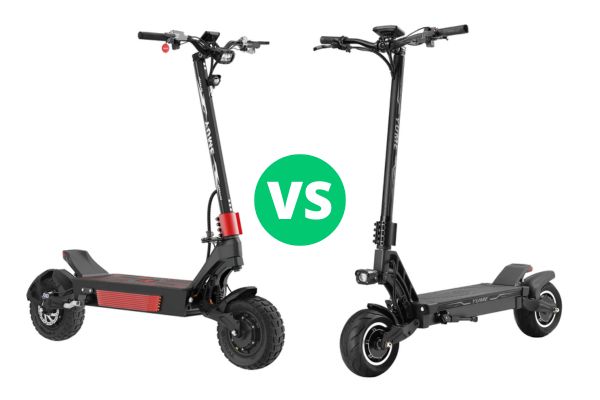Yume has quickly become one of the most talked-about brands in the electric scooter world. Known for offering high-performance models at prices lower than the big names, the company has started to move in two directions, one that focuses on pure power and another that focuses on next-level technology.
This article compares two top models from Yume: the Predator and the Hawk Pro. While they may seem similar at first glance, they are built for very different riders. The Predator is all about long-distance, high-speed stability and cutting-edge tech. The Hawk Pro is a lighter, more nimble scooter made for fun, fast, and aggressive rides at a much lower price.
Let’s break down what makes each one special.
Yume Predator vs Hawk Pro: Key Specs Compared
| Category | Specification | Yume Predator | Yume Hawk Pro |
| Motor Power | Nominal | 8000W (2 x 4000W) | 6000W (2 x 3000W) |
| Peak Power | 10,080W | ~6000W | |
| System Voltage | 72V | 60V | |
| Battery Capacity | 72V 50Ah (3600Wh) | 60V 30Ah or 27Ah (1800–1620Wh) | |
| Battery Cells | Panasonic EV cells | Samsung 21700 or standard | |
| Range (Claimed) | 100 miles | 60 miles (30Ah) / 56 (27Ah) | |
| Top Speed | 63 mph (100 km/h) | 50 mph (80 km/h) | |
| Real-World Range | ~48 miles | ~25 miles (aggressive) | |
| Tires | 13” x 4.73” all-terrain | 10” x 4.5” road | |
| Weight | 170 lbs (77 kg) | ~90 lbs (41 kg) | |
| Brakes | Quad-piston hydraulic | ZOOM dual-piston hydraulic | |
| Display | TFT (IP67 rated) | Color LCD (IP65/IPX6) | |
| App Support | Yes | Yes | |
| NFC Lock | Yes | Yes | |
| Price | ~$3,699+ | ~$1,549–$1,999 |
Motors and Controllers
The Yume Predator comes with two 4000W motors for a total of 8000W, and it can hit a peak of 10,080W. That’s extreme power. But what really sets it apart is its liquid-cooled controllers. This helps keep the electronics cool, so the scooter can perform at high speeds for longer without overheating. Most electric scooters slow down when they get hot, but the Predator is designed to keep going strong.
The Hawk Pro, on the other hand, uses dual 3000W motors and dual 35A sine-wave controllers. These offer smooth, quiet power and are cooled by airflow and heat-dissipation tubes. It doesn’t have the advanced cooling system of the Predator, but it doesn’t need it; I ts power demands are more manageable.
In simple terms, the Predator is like a highway cruiser meant for long, fast rides, while the Hawk Pro is more like a sports car that’s quick and nimble around town.
Battery Technology
The Predator’s battery is truly unique. It uses large Panasonic EV-grade cells, the same kind used in electric cars. This battery offers up to 2000 charge cycles, which means it can last many years without needing replacement. It’s also safer and easier to charge since it can be removed from the scooter. That’s helpful because the scooter itself is very heavy.
The Yume Hawk Pro uses high-quality Samsung 21700 cells, especially in the 30Ah version. These are common in high-performance scooters and offer good range and reliability. There’s also a cheaper 27Ah option for riders on a tighter budget. These batteries last about 500 cycles, so you may need to replace them sooner compared to the Predator’s pack.
So, while the Predator costs more up front, it may save you money in the long run by avoiding battery replacements.
Suspension and Frame
The Predator uses a complex suspension system with three hydraulic shocks, one in the front and two in the back. These are adjustable and designed to handle the scooter’s weight and speed, giving a smooth, planted ride even over rough roads.
The Hawk Pro keeps it simple but effective with dual adjustable hydraulic shocks. It also includes a steering dampener to help with stability at high speeds. This is a great feature on a lightweight scooter, making it feel more secure without losing agility.
In short, the Predator is built to stay stable at very high speeds. The Hawk Pro is built to turn quickly and feel light under your feet.
Tires and Handling
The tires play a huge role in how these scooters feel. The Predator rolls on giant 13-inch tires that provide excellent grip, ride comfort, and ground clearance. These tires help it cruise over bumps and cracks with ease. They also improve balance at high speeds.
The Hawk Pro uses wide 10-inch tires, which are great for street riding. They make the scooter feel more responsive and quicker to turn. These tires don’t soak up bumps as well as the Predator’s, but they offer great control on paved roads.
So again, it’s about what you value more: super-smooth rides at high speed, or tight control and fast turns.
Braking Systems
With its higher speed and heavier frame, the Predator needs serious stopping power. It comes with custom quad-piston hydraulic brakes and large 160mm rotors. These provide strong, fade-free braking even after long rides at top speed.
The Hawk Pro’s ZOOM dual-piston hydraulic brakes are among the best in its class and work very well for its size and speed. They are strong, smooth, and reliable, but they don’t have to work as hard as the Predator’s brakes due to the lower kinetic energy involved.
Weight and Portability
This is one of the biggest differences between these scooters. The Predator weighs a massive 170 pounds. That means you probably won’t be carrying it upstairs or loading it into your car. You’ll need ground-level storage or an elevator.
The Hawk Pro, at around 90 pounds, is much more manageable. It’s still heavy, but many riders can lift it into a trunk or over a curb. For daily use, especially if you need to move your scooter often, the Hawk Pro is way more practical.
Electronics and Features
Both scooters come with nice features like NFC lock/unlock, app control, and bright color displays. The Predator’s display is higher-quality and waterproof to IP67 standards, meaning you can ride in nearly any weather without worry.
The Hawk Pro’s display is also very good and easy to read, but slightly less weather-resistant. Still, it includes everything you’d expect: speed, battery, mode selection, and more.
Yume Predator vs Hawk Pro: Cost Breakdown: What Are You Really Paying For?
Let’s look at what you get for the extra money spent on the Predator:
| Premium Feature | Why It Matters |
| Liquid-Cooled Controllers | Allows for longer high-speed rides without overheating |
| EV-Grade Battery Cells | Longer lifespan, better safety, better long-term value |
| Quad-Piston Brakes | Safer stopping at higher speeds and heavier weight |
| 13-Inch Tires | More stable, smoother ride over long distances and rough roads |
| Triple Shock Suspension | Better comfort, especially on long rides |
| IP67 TFT Display | More durable and readable in all conditions |
| Removable Battery | Easier charging and storage |
So, yes, the Predator is expensive, but you’re not just paying for speed. You’re paying for future-proof tech, better safety, and longer lifespan.
Brand Trust and Quality Concerns
Here’s where things get tricky. While Yume offers a lot of value, it’s still growing as a high-end brand. Some users have reported issues like minor defects, loose bolts, or even frame cracks on other models. The Predator uses new and advanced tech, and while impressive, it comes with risks.
The Hawk Pro sticks to tried-and-tested parts. It uses known, reliable components and has been praised for solid out-of-the-box performance. You may not get the cutting-edge features, but you get something that’s easier to maintain and fix if needed.
For the Predator Rider: Tech-Lover and Long-Distance Cruiser
If you’re the kind of rider who wants the most advanced tech, rides far and fast, and treats their scooter like a full vehicle, not just a toy, the Predator is built for you. You’ll enjoy incredible comfort, better safety, and a future-ready battery. It’s heavy, pricey, and overbuilt for most city rides, but for long-range commutes or open-road cruises, it’s outstanding.
Go for the Predator if:
- You ride long distances regularly
- You value high-tech components and innovation
- You want something built for the future, not just today
For the Hawk Pro Rider: Thrill-Seeker on a Budget
If you’re looking for a wild, fun, and affordable ride that still packs serious performance, the Hawk Pro is one of the best values out there. It’s perfect for city commuting, quick weekend rides, or trail adventures. It’s fast, agile, and relatively easy to maintain. You get 90% of the power of a high-end scooter for less than half the price.
Go for the Hawk Pro if:
- You want strong performance at a reasonable price
- You enjoy fast acceleration and nimble handling
- You need something portable and practical for daily use
Conclusion
The Yume Predator and Hawk Pro represent two very different ideas of what an electric scooter should be. The Predator is a bold leap into the future,a scooter packed with high-end innovations and made for long, stable, high-speed travel. It’s expensive but justifiable for riders who want cutting-edge technology and long-term value.
The Hawk Pro is a smarter choice for most riders. It’s fast, fun, and much easier to handle, both in terms of weight and price. It sticks to proven designs and delivers real-world performance that satisfies without pushing the limits too far.
In the end, your decision comes down to how and where you plan to ride. If you want the best of the best and aren’t afraid to invest, the Predator is your machine. But if you’re chasing performance on a budget and want a scooter that thrills without the frills, the Hawk Pro is hands-down one of the best choices in its class.
Our Final Word: Unless you specifically need extreme high-speed stability and are ready to deal with a heavier, more complex machine, the Hawk Pro is the better fit for most riders. It’s fun, fast, and fantastic.




